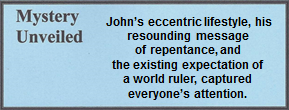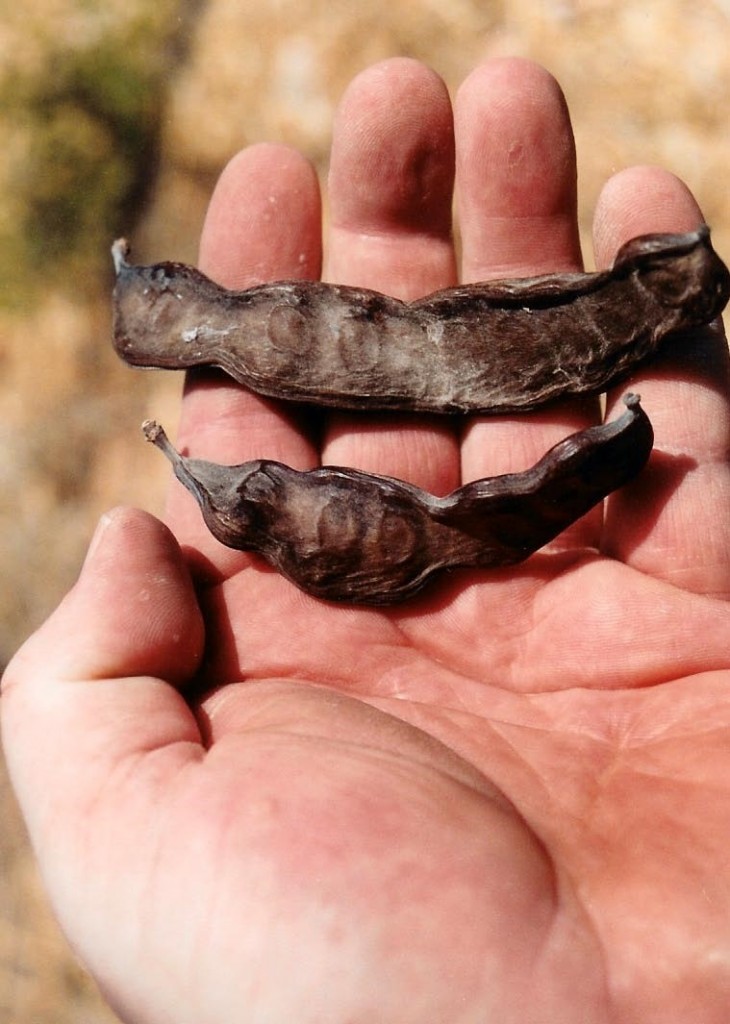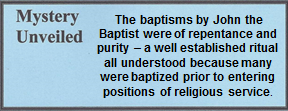05.01.03 Mt. 3:4-6 (See also Mk. 1:5-6) Along the Jordan River
JOHN BAPTIZES THE BELIEVERS
4 John himself had a camel-hair garment with a leather belt around his waist, and his food was locusts and wild honey. 5 Then people from Jerusalem, all Judea, and all the vicinity of the Jordan were flocking to him, 6 and they were baptized by him in the Jordan River as they confessed their sins.
John drew large crowds, in part because of his message, and in part because his miraculous birth was well known. His popularity escalated into what may be considered today as international status. The effect of his ministry can be seen in Acts 19, where the Apostle Paul met Jews in Ephesus who were baptized by John but had not heard of receiving the Holy Spirit. Obviously John never traveled to Ephesus, but distant Jews who came to Jerusalem took John’s message home with them. Eventually, some of them met the apostle.
“John himself had a camel-hair garment with a leather belt.” It is often said that John’s clothes and eccentric lifestyle echoed the prophet Elijah (2 Kgs. 1:8). Impoverished people who could not afford woolen clothing wore clothes woven from camel hair.[1] But more importantly, it was the custom of the Hebrew prophets to express themselves in a dramatic manner if they felt their words could not adequately communicate the message. John clearly identified with the ancient prophets as well as with the people who were reduced to economic slavery[2] by the Romans.
Just as both prophets, Elijah and Zechariah, sounded warnings to their people and predicted future events, and John did the same. He lived in isolation and identified with the misery of the peasant people, rejecting the comfortable wealthy lifestyle of the temple priesthood that he could have enjoyed. John seems to have had an immediate following. It is noteworthy that, centuries earlier, just as Elijah had his archenemies, Ahab and Jezebel; eventually John would have his, Herod and Herodias.

“Locusts and wild honey.” Eating locusts and honey was not a menu most people would consider, even in the worst of times, but the Baptist was different. The Mosaic Law prevents Jews from eating insects, with the exception of locusts, a/k/a “grasshoppers” (Lev. 11:22). However, it is highly doubtful these bugs were a part of John’s dietary plan for two significant reasons:
- The insect has only a short one or two month life cycle and, therefore, would only have been a brief menu option. Hence, John would have been starving about ten months of the year.
- The most likely definition is that the locust was the bean pod of the locust tree.[3] This wild edible plant has a taste similar to chocolate and is commonly known today as carob or carob pod.[4] The bean pod is found in abundance and would have been dried, stored in clay jars, and enjoyed throughout the year. More importantly, it was also the menu during times of famine, or by desperately poor people – the kind that might wear clothes made from camel hair. Even though this tree did not grow in the desert areas where John did most of his preaching, the pods are easy to carry and preserved well in the desert climate.

05.01.03.A. THE “LOCUST” OR FRUIT OF THE CAROB TREE. The carob tree was also known as the locust tree, which produces a bean that was commonly eaten by poor peasants. The beans can be stored year-round, while the locust insect has a life cycle of only one or two months. Photographed by the author who held two “locust” pods in his hand.
The locust pod, as a food source for the poor and during a famine, is found in the Babylonian Talmud. While that narrative is somewhat fanciful, it does refer to the carob bean as nourishing the whole world. In this case, the father of the young man, who may have had some messianic aspirations said,
The whole world will be nourished because of my son Hanina – and a morsel of carob bean will satisfy my son Hanina for a week.
Babylonian Talmud, Ta’anith 24b
Just as the word locust has a definition somewhat different from today’s concept, so does the word honey. The definition of the sweet syrup is not restricted to bee honey, but includes any type of sweet syrup originating from a plant or bee.[5] In this context, John’s diet most likely was date honey, or syrup from the date palm tree. This is found in the Jerusalem Talmud[6] as well as in Josephus. When Josephus described Jericho, which is near the area where John preached and baptized Jesus, he referred to the honey that was squeezed from the palm trees, as well as honey made by the honeybee.
There are in it (meaning “Jericho countryside”) many sorts of palm trees that are watered by it, different from each other in taste and name; the better sort of them, when they are pressed, yield an excellent kind of honey, not much inferior in sweetness to other honey. This country produces honey from bees; it also bears that balsam which is the most precious of all the fruits in that place.
Josephus, Wars 4.8.3 (468-469a)
Therefore, the phrase locust and honey was not to be literally interpreted according to modern definitions, but according to ancient definitions that were also symbolic of a poor and humble lifestyle of the prophets. This is an excellent example that demonstrates how a New Testament study cannot be complete without thorough study of the Hebrew Bible and, preferably, related rabbinic writings. The focal point is not the diet or lifestyle of the Baptist preacher, but his message, which was “clothed” in the message of earlier prophets.
Finally, for those who are die-hard loyalists to believing that John ate the bug locusts and not the bean pod locusts, the following two writers will be of particular interest:[7]
- Herodotus (484 – 425 B.C.) said that the insects were dried in the sun, ground into a powder, and then mixed with milk for a beverage.
- Diodorus Sisulus (1st century B.C.) wrote of a group within the population of Ethiopia, he called them “Acridophagous,” whose staple food was locusts preserved with salt to last all year.
While locusts and grasshoppers may have been a dietary delight in some cultures, for Jewish people, resorting to eating insects was a sign of poverty.
“Baptized by him.” The term baptize is from the Greek word baptismos or baptisma.[8] Its root word bapto means to dip, and as such was used by the Greek poet Homer to describe the dipping of hot steel in cold water to temper it.[9] The Hebrew counterpart is tabhal, and is often translated simply as to dip, as when Naaman dipped himself in the Jordan River (2 Kgs. 5:14).[10] Therefore, the Jews were already familiar with the rite of baptism. It was afforded to those who had become proselytes to the Jewish faith, of which some scholars believe there were many.[11]
05.01.03.Q1 What is the primary difference between immersion in a mikvah, and baptism?
Baptism was for the repentance of sin as well as a commitment to something – an office, a calling, or a way of life. It represented a chage of lifestyle. Immersion in a mikvah was for the removal of defilement, such as walking over a grave or touching a corpse. However, the ritual of dipping or immersion daily in a mikvah was not for baptism (repentance of sin) but for the cleansing of defilement. Priests immersed themselves daily before entering the temple. Also, the Essenes in Qumran immersed themselves three times daily to remain ritually pure.[12] In Jewish thinking, purity (Gk. katharos) was defined within the realm of physical, religious, and ethical purity; a term that has both figurative and literal requirements of behavior.[13] There are several unique features of John’s ministry and baptism.[14]
- The people remembered his miraculous birth and, so when he began to preach, crowds came to hear him.
- There were no miracles in the ministry of John, but the Holy Spirit functioned through his sermons of repentance.
- His baptisms did not have a concept of the death, burial, and resurrection as in the baptism of Jesus.
- His was a baptism of repentance and purity — that those who were baptized were sorry (repentant) for their sins and they dedicated themselves to live according to the precepts set forth in the Hebrew Bible.[15] The baptisms by the disciples were like those of John.
- John was the forerunner of the Messiah. Those who were baptized by him also identified themselves with him – and as such – they would identify themselves with the coming Messiah and the Messiah’s message about the Kingdom of God.
In 1947, when the Dead Sea Scrolls were discovered, Hebrew and Christian scholars were surprised to learn that the Essenes, who predated Christ by more than a century, had a doctrine and practice of baptism with amazing similarities to early Christianity. Namely, immersion with a repentant heart is a practice that is not found in any other Jewish writings of this time. In one of the scrolls known as the Damascus Document (a/k/a the Community Rule) is a rule in column three that states if a person immerses himself and is not sorry for his sins, he will not be forgiven, even with all the water in the world. Repentance was to be coupled with water immersion; the water cleans the body, the Holy Spirit cleans the inside of the person.[16] Therefore, many scholars believe the doctrine of baptism was not a new concept for the early church, but was patterned from the Essenes and their ritualistic baths.[17] However, this writer believes that the Essene practice of baptism may have been part of the meaning of the phrase “in the fullness of time,” Jesus came to this earth (Gal. 4:4). Men were ready for Him in ways beyond our comprehension.

Finally, for a point of clarification, John’s baptism was a repentance baptism for the forgiveness of sins. The baptism of Jesus is not only for the forgiveness of sins, but also for His redemptive work that is essential for salvation and eternal life.[18] It is the first step in the restoration of mankind to the image of God (see 16.1.18.Q3).
[1]. The camel hair garment was also reflective of the prophet Zechariah (13:4), who wrote the prophetic Old Testament book that bears his name.
[2] The subject of high taxation that resulted in economic slavery is presented by Josephus, Antiquities 17.11.2 (307-308). See also 02.03.03 “Economy” and 03.06.04 “4 B.C. The Death of Herod the Great.” See also Sanders. “Jesus in Historical Context.” 430.
[3]. Avi-Yonah and Kraeling, Our Living Bible. 272.
[4]. Bacon, Walking Beside Jesus. 33. This tree with its carob pods are grown at the Holy Land Museum and at Neot Kedumim, a biblical landscape reserve located northwest of Jerusalem. Geikie, The Life and Works of Christ. 2:351.
[5]. Pilch, The Cultural Dictionary of the Bible; 54. Trever, “Palm Tree,” 3:646.
[6]. Bacon, Walking Beside Jesus. 33; Jerusalem Talmud, Bikkurim 1.3; Hareuveni, Nature in Our Biblical Heritage. 35.
[7]. Klausnitzer, Insects: Their Biology and Cultural History. 51
[8]. Vincent, Word Studies in the New Testament. 1:199-200.
[9]. Homer. Odyssey. 9.392.
[10]. Williams, “Baptize, Baptism.” 27-30.
[11]. Dugas. “The Reaction of the Hellenistic World to Judaism.” 67-73.
[12]. Harrison, A Short Life of Christ. 66-70.
[13]. Link and Schattenmann. “Pure, Clean.” 3:102-03.
[14]. According to Scott, Jr. Jewish Backgrounds of the New Testament. 146, one of the earliest scholars to research Jewish baptisms was a French scholar, Joseph Thomas, who authored Le Mouvement baptist en Palestine et Syrie (Gembloux: J. Duculot, 1935). For more on Jewish baptisms, see 05.05.02 and Nicodemus in 05.05.05.
[15]. Farrar, The Life of Christ. 109.
[16]. Martinez, The Dead Sea Scrolls Translated. 5.
[17]. For more information on baptism, see 05.05.05.Q2 and Q3.
[18]. Beasley-Murray, “Baptism.” 1:146.